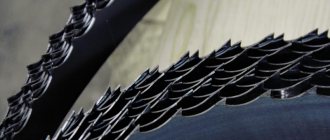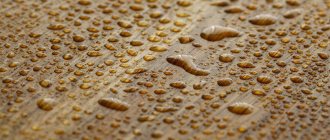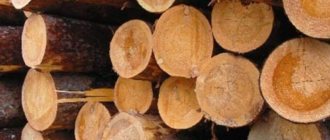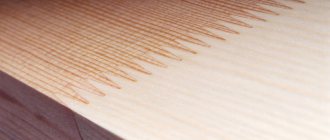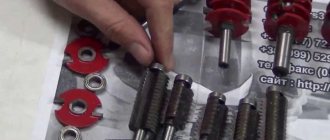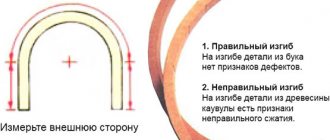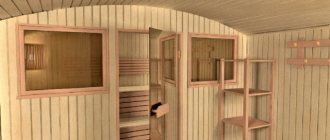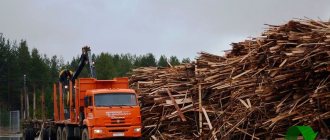The greening trend has affected all areas of the forestry industry, not excluding the segment of laminated materials and structures. For gluing, manufacturers use special compounds that, under pressure, penetrate into the deepest pores of the wood, providing the finished products with a high margin of safety. With the right choice of glue, wood can remain a “breathable” material, will not release toxins and will retain these properties throughout the entire life cycle of the product.
OSB, fibreboard, MDF, chipboard, LVL, CLT - this parade of abbreviations can be combined with the concept of “laminated wood products”. For each type of product, manufacturers select their own glue based on the properties of wood raw materials, technological features of production, as well as the design, operational and aesthetic characteristics of finished products.
Emphasis on environmental friendliness: it is better to choose a harmless material for gluing wood
However, there are requirements that are common to all adhesives without exception: good gluing quality, ensuring high strength of the adhesive seam, resistance to temperature, chemical and humidity influences, reliability and durability. Recently, manufacturers and users are paying more and more attention to another important characteristic - the environmental friendliness and safety of the materials used. And if there are no questions about wood, then the adhesive compositions used to connect individual wooden elements often raise doubts about their harmlessness to humans and the environment.
“The environmental safety of the materials and adhesives used has been and remains an important production factor. It is important both in the production of wood materials themselves from waste from the wood processing industry (MDF, OSB, chipboard) and in the production of structures from solid wood (laminated veneer lumber, furniture panels, furniture).
By environmental safety of products we mean the absence of their negative impact on the environment during the manufacturing and disposal process, on personnel during production and on users during the operation of finished products. Compliance with these parameters is monitored at all stages of the product life cycle.
It is safety, all other things being equal (moisture resistance, strength and other technical indicators of the resulting adhesive joint) that will further determine the possible area of application of glued materials: indoors in finishing and making furniture, in exterior finishing of premises, in house construction and other areas,” the specialist lists technical support of Polymer-sbyt LLC (UMACOLL® trademark) Svetlana Burova.
“Of course, manufacturers of furniture components cannot remain aloof from the struggle for environmental friendliness and safety of their products. And every year this struggle gets tougher. It covers the entire life cycle of a furniture product from its “birth” during the production process to its “death” at the time of disposal. For example, polyurethane (PUR) adhesives are increasingly used in the production of laminated veneer lumber and CLT panels in Europe.
They replace adhesives based on urea-formaldehyde or melamine that have been used for many years. Also popular are PUR hotmelt adhesives, which have a wide range of applications including edge bonding, face cladding, profile wrapping and other processes. They are characterized by a reduced content of isocyanate monomer, do not require the creation of special labor protection conditions and are absolutely harmless to both production workers and users of finished products.
On the other hand, biocomponents are increasingly used in adhesive formulations, which makes them cleaner at the stage of product production, its operation and subsequent disposal,” notes General Director Nikolai Kechaev.
For reference, the list of harmful chemicals released from furniture is contained in the Technical Regulations of the Customs Union “On the Safety of Furniture Products” (TR CU 025/2012), effective from July 1, 2014. Requirements for wood boards, plywood and other glued materials are contained in the regulatory documentation for them and the guidelines of the Ministry of Health of the Russian Federation “Sanitary and hygienic assessment of polymer and polymer-containing building materials and structures intended for use in construction and industrial buildings” (MU 2.1.2.1829- 04).
Gluing wet wood
When organizing the mass production of glued sleepers and beams, difficulties may arise associated with drying a large amount of lumber to a moisture content of 15-18%, which is necessary to obtain a strong adhesive seam using the conventional technology of gluing wood with phenol-formaldehyde glue KB-3. Therefore, the possibility of gluing wood with high humidity was studied.
It is known that using casein-cement glue (CC) it is possible to glue elements with a moisture content of up to 25%, which was confirmed by our research. However, the elements glued with this glue turn out to be short-lived under operating conditions. Thus, the experimental glued sleepers fell apart after six months of use on the road. Therefore, KC glue cannot be recommended for gluing wet wood in the manufacture of sleepers and beams.
Work was carried out to study methods for gluing wet wood with phenol-formaldehyde adhesives. This article serves to introduce the types of wood gluing, so the entire research process will not be described. Let’s just summarize the important results: Conclusions:
- The possibility of gluing wood with a moisture content of up to 35-40% with KB-3 glue has been established, provided that the surfaces to be glued are heated by contact at a temperature of 160-170° for 10-20 minutes.
- Gluing wood with a moisture content of up to 40% is possible if gypsum mastic is applied to the bonded surfaces.
- The possibility of drying wood of any moisture content in molten sulfur has been established. After gluing dried wood with KB-3 glue, a strong adhesive joint is obtained.
- After appropriate testing and clarification of technical and economic efficiency, the developed methods for gluing wet wood can be recommended for use.
When you don’t need to make a choice: how to choose a material for gluing wood and not make a mistake
Not all compositions are suitable for the production of glued materials and structures intended for direct human use. Some adhesives contain many harmful components, and although after hardening most of them do not emit volatile substances, some ingredients have a long final polymerization in the deep layers of wood. The finished product can be considered environmentally friendly only if it strictly complies with GOST and SanPiNam.
“The quality of gluing is clearly regulated by regulatory documentation, and conscientious manufacturers do not use products that do not comply with them. High-quality adhesives must satisfy absolutely all current standards and regulations, while meeting the manufacturer’s requirements for moisture and heat resistance of products made with their use.
So the concepts of “sustainable” and “eco-friendly” are not mutually exclusive and can be specific to the same product. But you should understand that each group of products (plywood, OSB, laminated timber, etc.) has its own criteria for moisture resistance, heat resistance and environmental friendliness,” says Svetlana Burova.
Nikolay Kechaev is also confident that the use of more environmentally friendly components should not come at the expense of the quality of products. In his opinion, the use of modern safe adhesives does not reduce the resistance of finished products to moisture and temperature.
“New adhesives, created taking into account higher requirements for environmental friendliness, must provide stable technological properties. This may lead to a slight increase in the price of a particular glue, but may not affect its cost at all,” comments the CEO.
Svetlana Burova confirms that the cost of new generation adhesives, which minimize the content of harmful substances, may be higher than the price of previously used ones. But manufacturers of glued products are willing to pay more, because compliance with environmental requirements provides them with significant competitive advantages in the sale of finished products and has a positive effect on the company’s image.
Theories of adhesion. Mechanical theory of bonding
The earliest theory explaining the effect of adhesion and gluing of bodies is the mechanical theory of gluing developed by McBain. Bonding strength, according to this theory, is explained by the penetration of liquid or liquid-viscous glue into the pores of the bonded surfaces, followed by its hardening.
Indeed, the large surface covered with glue (the so-called glue locks), the shape of the pores into which the glue penetrates, the strength of the glue itself and the peculiar isthmus bridges that make up the pore walls provide a high gluing effect.
Unfortunately, the mechanical theory is not able to explain the strong bonding of relatively smooth surfaces of metals, glass, porcelain, etc. It also does not explain why smooth planed wood surfaces sometimes bond better than fine-haired ones. This theory does not take into account the most important factor - the nature of the bodies being glued and the nature of the glue itself. It arose at a time when, as a rule, protein adhesives (hidewood, gelatin, casein) were used as an adhesive, and wood was used as a bonding material.
No law - no reason
In the liquid state, before polymerization, most of the adhesives used in the production of glued structures belong to the first hazard class. You can check this by studying the safety data sheet for a specific adhesive system. However, this does not mean that toxic compounds are completely absent in modern Russian language.
“Unfortunately, in the Russian market of chemical materials in general and adhesives in particular, the desire of manufacturers to use less toxic or harmful materials is far from desired. The reasons lie both in the lack of a strict legislative framework and in the desire to gain benefits here and now, without thinking about the future.
Greater social responsibility for the fate of consumers of products manufactured in violation of safety requirements could encourage industry to switch to environmentally friendly materials if this were supported, for example, by providing tax benefits from the state,” says Nikolai Kechaev.
“There are no direct restrictions on the use of adhesives of one type or another; manufacturers are limited by standards for the release of harmful substances from the finished product for various categories of goods. Products that do not meet the standards will simply not be allowed for sale.
Therefore, when choosing an adhesive composition for a product, manufacturers take into account the possibilities of its sale, taking into account the resulting safety category,” explains a technical support specialist at Polimersbyt LLC.
Film veneering
Covering furniture with films is as follows. A sheet of film is placed on the prepared surface of the base. If the film does not have adhesion to the base, then glue is first applied to the base. A polished metal gasket is placed on top of the film, and a shock absorber made of cardboard or asbestos fabric is placed on it. The shock absorber increases the service life of polished pads and makes it possible to more evenly distribute pressure on the base during pressing. If it is necessary to obtain an embossed coating, then instead of metal spacers, a fiberglass matrix is used, which has anti-adhesive properties to the film. During the hot pressing process, the matrix, depending on the pattern applied to it, leaves an embossing on the finished surface.
The formed bags are loaded into a hydraulic press and pressed for 8–10 minutes at a temperature of the press plates of 110–150°C. The specific pressure during pressing is 20–25 kgf/cm2 if gluing occurs without the use of adhesives, and 5–8 kgf/cm2 when using adhesives.
Under the CH2O sign
Perhaps the most important “horror story” when using glued materials and structures is the presence of formaldehyde in them. It has a general toxic, carcinogenic and mutagenic effect on the human body, where it enters mainly in the form of vapors emitted by new furniture, some paints and finishing materials.
The degree of harm caused to the body directly depends on the volume of its release (emission) and the duration of exposure. Formaldehyde tends to accumulate in some organs, and with systematic exposure, sensitivity to it increases.
“However, formaldehyde cannot be completely eliminated from our lives. It is produced in small quantities by living organisms (it is involved in metabolism), and even such an environmentally friendly material as wood contains a small amount of formaldehyde (<0.03 ppm).
The general trend throughout the world is strict regulation and reduction of the formaldehyde content in products to a natural, environmentally friendly level, at which the body is not exposed to harmful effects. The permissible level of formaldehyde emission from wood materials in Europe, the USA and Japan is set by internal standards: for Europe these are classes E1 and E2, for Japan - F* - F****, for the USA - CARB1 and CARB2.
In Russia, according to the degree of formaldehyde emission, the material is assigned class E1 or E2. The IKEA company in its standard IOS-MAT-003 establishes class E0.5 (formaldehyde emission 0.05 ppm), GOST 3916.1 - 2022 also allows this class.
Since 2006, class E1 is mandatory for plywood and wood panel materials in Europe (not more than 0.124 mg/m3). Such materials can be used in the production of household furniture and furniture for public premises, as well as products used inside living rooms,” notes Svetlana Burova.
In her opinion, there is currently no need to abandon formaldehyde adhesives. The very presence of this substance in the product should not be scary; the main limiting factor in this case is its subsequent release into the environment.
This can be confirmed by a number of modern adhesive products containing formaldehyde, the environmental safety of which has been tested and confirmed by current standards. Examples include low formaldehyde emission formaldehyde resins (PF, MF, MUF, RF and PRF) or isocyanate resins (PMDI).
Formaldehyde-free adhesive products are also available on the market - these are polyurethane adhesives and EPI (emulsion polymer isocyanate) adhesive systems. Scientists continue to search for safe compounds, experimenting with the formulations of adhesive compositions, creating new sorbents for toxic substances and using more environmentally friendly starting components.
A method has already been found for preparing formaldehyde-based glue using readily available aluminosilicates with a rigid frame structure of synthetic and natural origin. The strength of products made using this aluminosilicate-modified adhesive increases compared to products made using a traditional adhesive formula.
Nikolai Kichaev, in addition to this, notes that in some cases, adhesive compositions not only do not cause harm to humans and nature, but also help reduce the volume of harmful fumes from products. For example, this effect is achieved by covering chipboards with decorative films and edges. Primers, putties and varnishes can also act as such “barrier” finishing materials.
They can reduce formaldehyde emissions from 2 to 10 times. If initially a dry board contains 40–100 mg of formaldehyde per 100 grams, then after finishing with a laminate, the emission decreases to 10–18 mg, if the finishing is done without sealing the ends, and with sealing - to 2–4 mg. To reduce the toxicity of chipboard used in construction, formaldehyde-binding paints and enamels are used - thanks to this finishing, toxic emissions from the boards are reduced by 50–60 times.
Applying glue by hand
Adhesives are usually applied to one of the surfaces to be bonded. Only when gluing surfaces that strongly absorb glue after application (ends, ends), use double-sided application.
In Fig. 2 shows devices for applying glue.
Rice. 2. Device for applying glue manually: a – with an upper tub; b – with a lower bath; 1 – bath; 2 – glue; 3 – handle; 4 – dosing roller; 5 – glue application roller; 6 – adjustable gap; 7 – ruler
A device with an upper bath (Fig. 2, a) consists of a bath 1 with glue 2, two metal rollers - dosing 4 and glue-applying 5, handle 3. The glue-applying roller is lined with soft porous rubber or foam rubber. The supports of both rollers are fixed in the guides, but can be moved up or down, which allows you to adjust the size of the gap 6 between the lower edges of the walls of the bath and the surface of the metering roller. This way you can change the amount of glue supplied. When applying glue, the device is held by the handle and rolled on the surface of the base.
A device with a lower bath (Fig. 2, b) consists of a bath 1, a glue-applying roller 5 and a ruler 7 for removing excess glue from the roller. The device is installed on the table. To apply the glue, the workpiece is passed over a roller.
Once again about processing
It is important to remember about the environmental friendliness of laminated materials and structures not only at the stages of production and operation, but also when a laminated wood product completes its life cycle. The best-case scenario in terms of environmental impact is the recycling of wood products for secondary use. Unfortunately, in our country it is still associated with a lot of difficulties.
This was clearly demonstrated by the experience of implementing the “New Life of an Old Cabinet” project, which was organized by the Association of Furniture and Woodworking Industry Enterprises of Russia (AMDPR). IKEA also became its participants - today they are the only players in the Russian woodworking market that offer services for collecting old furniture for its subsequent processing.
Of course, this is negligible. But even if there were more processing capacities, this is not enough for success - active involvement in the chain of government bodies and the population is necessary. To make it interesting for citizens to support the wood products processing cycle, collection points and competent logistics are needed. So far, the Russian timber industry cannot boast of this.
“Companies themselves are engaged in establishing logistics chains for the supply of recycled wood and used furniture. That is, the IKEA and Kronospan projects are, by and large, an internal corporate initiative, which can hardly be extended as an algorithm to the Russian Federation as a whole. This is still a big problem in our country,” noted AMDPR General Director Timur Irtuganov at the Woodindex-2020 online conference “Investments in the timber industry and pulp and paper mills: growth points and development directions.”
In addition, serious limiting factors in the development of recycling of wooden products are the lack of a legislative framework on this topic, as well as the lack of specialized equipment and investments for its acquisition.
Adsorption theory
This theory considers the formation of an adhesive joint as a multi-stage process. At the first stage, as a result of thermal (Brownian) motion, movement occurs - migration of large molecules of the adhesive polymer from the solution to the surface of the substrate. The second stage of bonding, according to this theory, is adsorption. When the distance between the molecules of the glue and the substrate becomes less than 5 A, intermolecular forces will begin to act, which, as already noted, can be of a very different nature: dispersive, inductive, orientational and hydrogen, with a binding energy of 0.1 kcal/mol (dispersive) up to 10 kcal/mol (hydrogen). The third stage of gluing is the removal of solvents from the adhesive solution, increasing the cohesive strength of the adhesive so that its cohesion achieves adhesion. If viscous polymers are used as an adhesive, then the third stage will be the process of strengthening the polymer.
The adsorption theory of adhesion has become widespread abroad, although it has a number of disadvantages. In addition, it does not take into account the phenomena of electrification of adhesion planes, as well as the peculiarities of the behavior of polymers that distinguish them from liquids and elastic bodies.
Electrical theory of adhesion
The theory was proposed by B.V. Deryagin and N.A. Krotova (USSR); it is based on the phenomena of contact electrification that occurs during close contact between a dielectric and a metal or between two dielectrics.
The adhesive system - the material being glued, according to this theory, is identified with a capacitor, and the double electrical layer that appears when two dissimilar surfaces come into contact is identified with the capacitor plates. When the glue is separated from the surface or, which is the same thing, the capacitor plates are separated, a potential difference arises, the magnitude of which increases with the increase in the gap between the surfaces being separated to a certain limit, when a discharge occurs. The work spent on spreading the surfaces turns out to depend on the speed: the lower the speed, the less work is required to separate the surfaces, because the charges have time to flow off. With rapid dilution of surfaces, the high initial density is maintained until the onset of a gas discharge. This ensures that the work of adhesion is of great importance, since the action of electrostatic forces of attraction is overcome over relatively large distances.
As for the reason for the formation of a double electrical layer at the interface between two surfaces (glue - glued material), there are two assumptions. In one case, its appearance is explained by the adsorption of glue by a solid surface and the orientation of the polar groups of the glue on this surface. In the second case, when it comes to gluing metal, the formation of this layer is explained by the transfer of electrons into the glue. The electrical theory of adhesion is not universal, since it cannot satisfactorily explain the formation of an adhesive bond between polymers that are similar in nature; does not explain why nonpolar polymers, in which an electrical double layer is not formed, can still form a sufficiently strong bond.
It should also be pointed out that a number of characteristic phenomena during the destruction of adhesives, which serve as the main proof of the correctness of the electrical theory of adhesion, appear only under certain conditions, when the adhesives are previously well dried. When freshly prepared adhesives delaminate, no electrical charges are observed, and the strength of the adhesives is still quite high.
